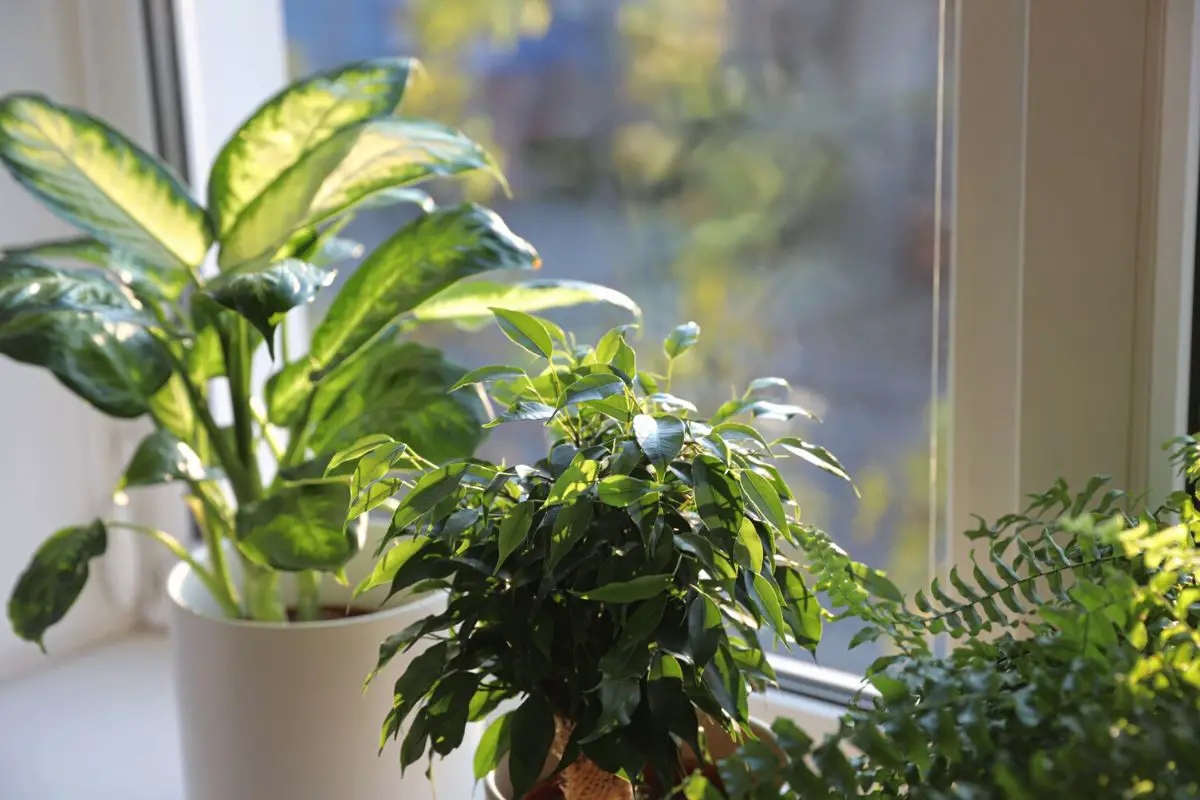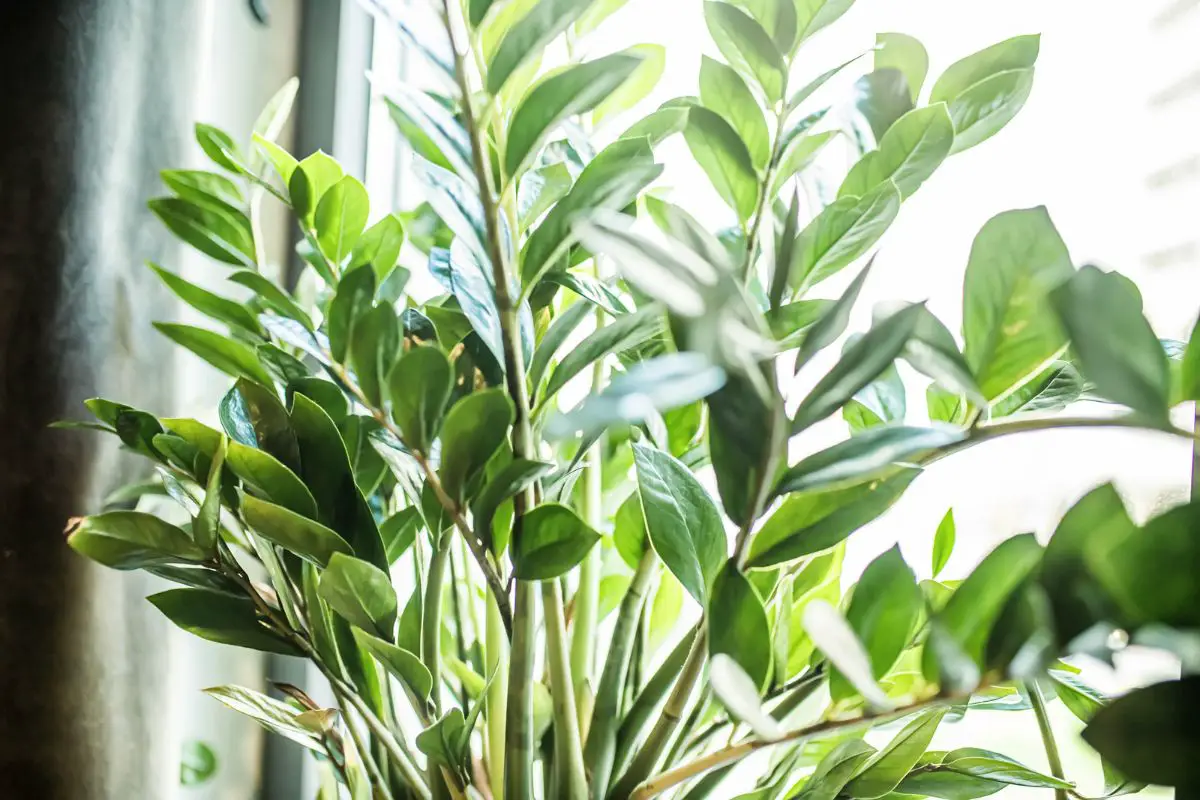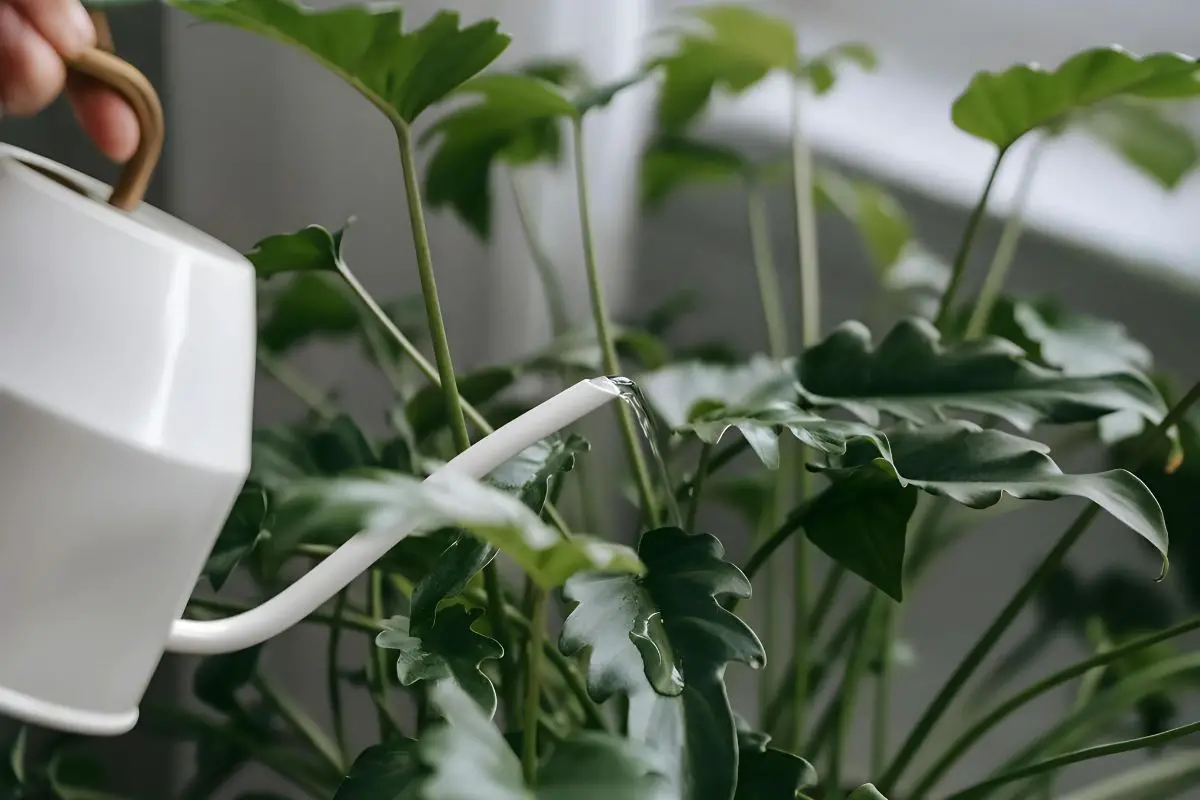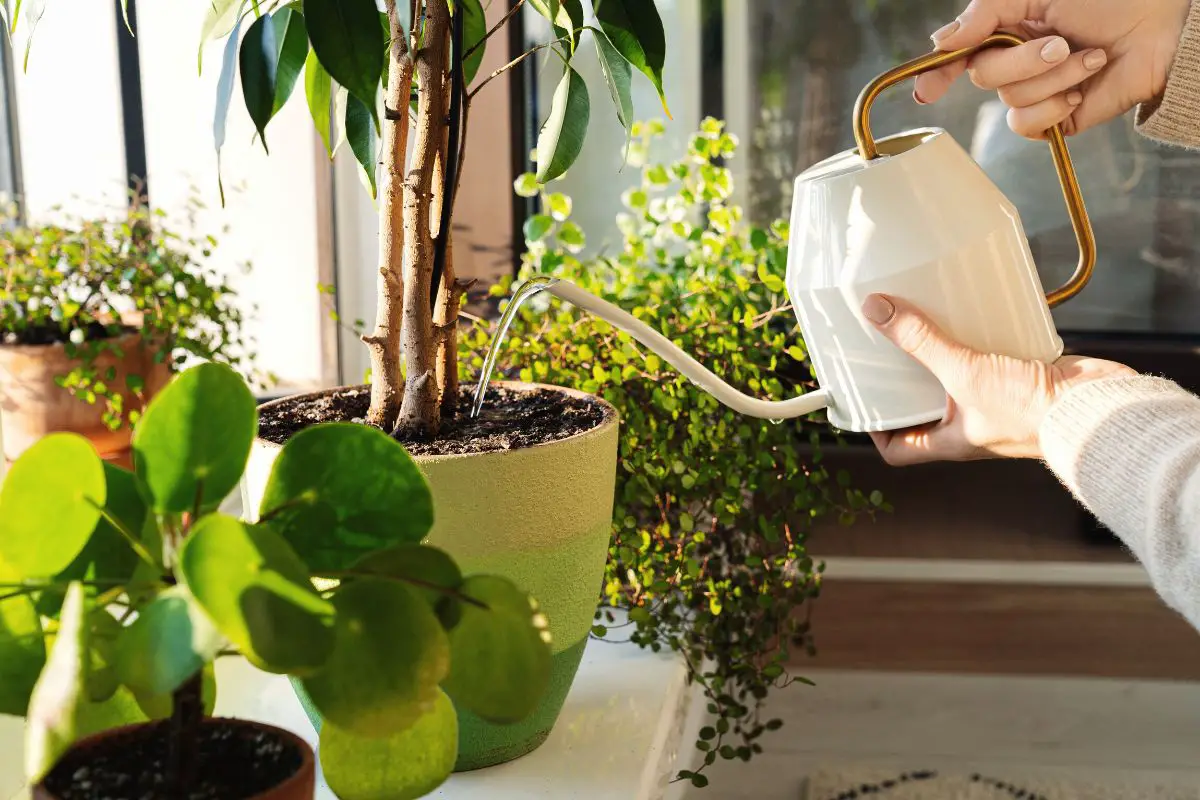ZZ plants are tropical natives with evergreen leaves. Under optimal conditions, they don’t shed leaves, even during the cold season. Therefore, leaf drops can indicate an underlying problem that needs immediate attention.
The primary causes of leaf drop in ZZ plants include:
- Underwatering
- Overwatering
- Relocation or transplant shock
This article will discuss these causes in more detail to help you understand why your ZZ plants might be dropping leaves. I’ll also share other associated symptoms to help you correctly identify and fix the problem.

ZZ Plants: An Overview
ZZ plants (Zamioculcas zamiifolia) are famous for their glossy emerald leaves that can last around 2-6 months before fading. This long lifespan can be attributed to their adaptations to their native environment, which has loose soil, scarce rains, and dappled sunlight.
They have developed an efficient moisture and nutrient storage system through their fleshy roots, stems, and rhizomes or bulbs. The stored resources can keep the foliage vibrant even after several weeks of drought.
The leaves can last longer indoors when kept at regular watering schedules and stable environmental conditions. After a few months, older stems and leaves will look paler and sometimes turn yellow. If left unpruned, the leaves will eventually drop.
You can rule out aging from the unnatural causes of leaf drop if only the older leaves are shedding.
Conversely, if the younger leaves (less than 2 months) are falling and your plant is showing the additional signs listed below, it’s important to inspect your plant carefully to identify and properly address the problem quickly.
Symptoms of Leaf Drop
ZZ plants are generally resilient and it can take long periods of neglect before they show distress.
You can often tell early signs of stress in ZZ plants based on leaf discoloration. Leaf drop, on the other hand, can indicate a late-stage health problem that needs urgent solutions.
Here are the symptoms that precede leaf drop:
- Drooping and wilting
- Yellow leaf tips
- Brown and crisp leaf edges
- Dry, crusty soil
- Brown, mushy sections on the leaves
- Wet, soggy soil
- Foul-smelling black roots and bulbs
- Paler or yellow stalks
These symptoms can progress if left unattended, and you’ll notice the leaves hanging limp from the petioles until they eventually fall off.
Common Causes & Fixes
Let’s explore the common causes of leaf drop in ZZ plants and how to fix them:
Underwatering
ZZ plants can last several weeks without water during the growing season and up to 2 months during winter. However, leaving your plant unwatered for too long can exhaust the moisture stored in the stems and bulbs.
The shoots will then show early signs of dehydration, including the following:
- Drooping or wilting stems or leaves
- Wrinkling leaves
- Yellow leaf tips that eventually turn brown and crisp
- Dry soil with a crusty or cracked surface
As the dehydration progresses without solutions, you’ll notice the following additional signs:
The length of time ZZ plants can go without water can be significantly reduced when exposed to the following conditions:
- A few hours of direct sunlight daily can dry out the soil and leaves more quickly.
- Temperatures constantly over 80 °F (27 °C) can increase the evaporation rate from the leaves.
- Humidity levels below 30% can increase the transpiration rate.
- Excess fertilizer salts in the soil can drain the moisture from the roots and bulbs.
These conditions can worsen the signs of dehydration and prompt your plant to shed leaves as a self-preservation response. Since this is most likely a late-stage issue, you’ll need a more thorough solution to revive your plant.
Here are the steps:
1. Prune the Damaged Shoots
Use sterile shears to cut discolored or dried-out stems up to an inch (2.5 cm) above soil level. Don’t worry about heavy pruning, even if more than half of your plant is dry. It has enough energy in the bulbs that it has to preserve to support new growth.
2. Perform a Water Absorption Test
Add a few drops of distilled water to the soil surface. Water beads forming on the surface mean the soil has become hydrophobic. If the beads remain on the surface for longer than 4 minutes, it means the condition is severe.
3. Rehydrate Hydrophobic Soil
Dunk the pot into a tub of tepid water (around 68 °F or 20 °C) for about 30 minutes to an hour to fully rehydrate the soil. You may need to keep the pot submerged using a heavy stone to keep it from floating.
Alternatively, you can dunk the pot in water with a wetting agent for faster results. In most cases, you must dilute the wetting agent in water and soak the soil in it for 5-10 minutes. Be sure to check and follow the product label and instructions for the best results.
4. Repot the Plant in Fresh Soil
If the soil is severely hydrophobic and you don’t have a wetting agent on hand, it’s best to repot the plant in fresh soil with better moisture retention.
Use equal parts compost and perlite. Compost is rich in organic matter and can introduce a mild dose of nutrients to the recovering bulbs and roots. It can also hold enough moisture to rehydrate your plant properly.
On the other hand, individual perlite particles also hold onto moisture and drain the excess along the pores or channels between them. This allows your plant to absorb enough water without sitting in constantly wet substrate.
5. Improve Your Watering Routine
For optimum health, it’s best to water your plant every 2-3 weeks while it’s actively growing. 10 days after watering, check the soil moisture. You’ll know it’s time to water your plant if the top half of the potting mix is completely dry.
You must adjust the watering frequency depending on the temperature and light intensity during the season. This can be as often as every 10-14 days in summer or every 4-6 weeks in mid-fall until winter.
Overwatering
As drought-tolerant plants, ZZ roots and bulbs dislike constantly wet soil, which can lead to root rot. The fleshy roots and bulbs require loose soil to drain excess moisture and maintain good air circulation.
Here are the factors that contribute to overwatering:
- Frequent watering
- Soil mix with poor drainage
- Oversized pot
- High humidity (over 60%)
- Low temperatures (below 65 °F or 18 °C)
- Low light conditions
Overwatering symptoms can progress in the following steps:
- Excess water is transported to the leaves, causing guttation or water-soaked spots.
- The suffocated roots and bulbs can’t send moisture and nutrients to the shoots, so the leaves turn yellow.
- Anaerobic soil pathogens multiply and feed on the roots and bulbs, causing decay and foul odor from the soil.
- The leaves become dehydrated and fall off.
The rot or decay will climb toward the stems and leaves, potentially killing the plant as quickly as 1-2 weeks if the soil is constantly soggy.
It’s important to act fast to treat your plant. You must unpot the plant, prune all the damaged sections, and repot it in a sterile pot with fresh soil mix with better drainage. Remember the proper watering tips discussed above the avoid overwatering your plant again.
In severe cases of root rot, the only option left is to collect any remaining healthy leaves for propagation.

Relocation or Transplant Shock
ZZ plants may also shed leaves due to relocation or transplant shock.
Here are the factors that contribute to this issue:
- Poor-draining soil
- Oversized pot
- Too much direct sunlight or insufficient light
- Overwatering
- Underwatering
- Fertilizer burn
- High temperatures
To save themselves, ZZ plants will drop their leaves. Entire stems may sometimes die back as the plants struggle to preserve resources.
Newly rooted stems or leaf cuttings might not survive another transplant too soon, so it’s best to try moving them to better environmental conditions and improve your plant care routine (which I’ll discuss below).
When relocating the plant to different light conditions, do so gradually. For instance, move it only one foot (30 cm) toward or away from the window every week. Observe your plant’s reaction to the new environment until you find its comfort zone.
Routine Care and Maintenance
Maintaining good care practices and environmental conditions is crucial to keep your mature or newly transplanted ZZ plants thriving.
Here are some sure-fire ways to keep your ZZ plant happy and prevent leaf drop:
- Water: Give the rootzone time to dry, but don’t wait until the soil mix is bone-dry all the way through. Water your plant as soon as the top half is dry. In winter, you can wait 4-6 weeks between watering sessions to let your plant rest and store energy for the growing season in spring.
- Light: Aim for 8 hours of bright, indirect sunlight or 12 hours of artificial light daily for optimum ZZ plant health. Avoid direct sunlight for more than two hours a day. Give the pot a quarter or a half turn every time you water your plant for even light distribution and bushy growth.
- Temperature: ZZ plants like warm temperatures ranging from 65-85 °F (18-29 °C). Increase the watering frequency accordingly at temperatures over 80 °F (27 °C) to prevent dehydration.
- Soil Management: Use high-quality compost in a homemade mix or a reputable succulent mix to ensure your plant receives proper drainage and a moderate dose of nutrients. Top up the soil regularly to cover any exposed bulbs and keep them ½-1 inch (1.3-2.5 cm) below the surface.
- Fertilizer: Avoid fertilizing your ZZ plant soon after repotting. If the fresh soil mix has nutrients, you can wait until the following spring to fertilize your plant with slow-release granules or half-strength 10-10-10 liquid fertilizer.
- Pest Management: Inspect leaf undersides and stems for signs of aphids, mealybugs, and scale mites. These pests tend to attack stressed ZZ plants. Spot-remove pests as you see them and spray your plant with neem oil solution to prevent further attacks.
- Repotting: Repot ZZ plants every 2-3 years to refresh the soil and give your plant more space to grow.
- Root Pruning and Division: Prune damaged or decayed roots and bulbs as you divide your plant every 3-5 years. This can help improve root health and plant vigor.
Final Thoughts
Perky emerald leaves are the crowning glory of ZZ plants. They tend to droop, wrinkle, or appear yellow, which indicates early signs of stress.
Premature leaf loss due to watering problems and transplant shock can indicate severe plant damage that can sometimes be irreversible. Even the sturdy ZZ plant will die when constantly exposed to suboptimal conditions.
Therefore, regularly inspecting your plant is important to catch and treat problems early.
Comment below to share your experience with dropping ZZ leaves and tips on how you fixed the problem. This is a great opportunity to share insights with fellow ZZ plant enthusiasts.







